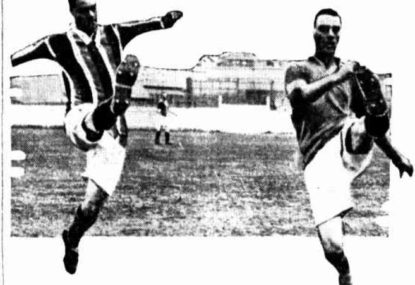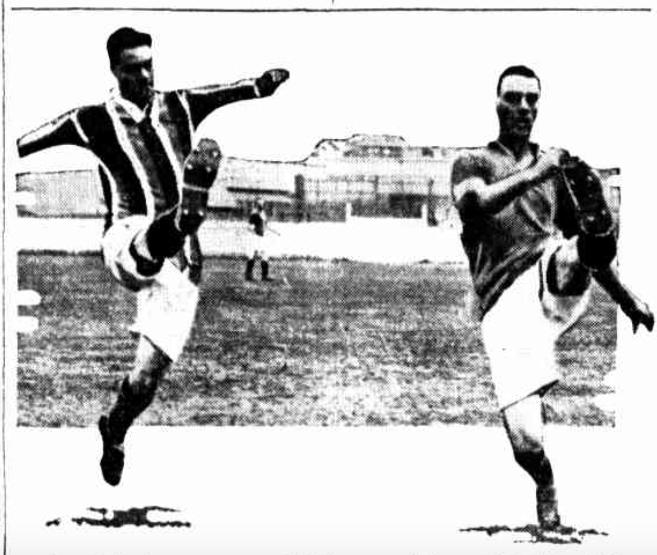Controversy as Villa keeper handed second yellow for shootout crowd taunting... but isn't sent off
Emi Martinez was saved by a new rule that resets yellow cards at the end of extra time, meaning his second yellow for taunting…

One of the joys of watching Sydney FC over the past few seasons is seeing their classy European imports pick apart opposition defences.
Slovak Filip Holosko, Poland’s Adrian Mierzejewski, and Serbia’s Milos Ninkovic, are the latest in a long line of players from Eastern Europe and the Balkans who have helped enrich football in Australia.
Australia’s football links with the region are very much entwined with the wave of migration following the end of World War Two.
The Slavia club of Melbourne was formed by Czech migrants in 1950. Its Sydney based counterpart, Prague, was established in 1957.
There have been teams bearing the ‘Croatia’ name in Sydney and Melbourne since the 1950s.
Both South Melbourne and Sydney Olympic can trace their lineage to clubs formed by Greek migrants in the 1950s.
[latest_videos_strip category=“football” name=“Football”]
How far back does this connection with the eastern half of Europe go? At least as far back as 1949, just four years after the end of the war, when Polish migrants in Sydney formed the Polonia club.
But I have traced a link even further, to not long after the First World War, when a young man from Czechoslovakia played club football in Sydney.
That man’s name was Oldrich Pozdilek. In 1924 he was living in Paris, working at a branch of an American bank during the week and playing football on the weekends.
No doubt keen to see the world, Pozdilek took up a posting to the bank’s Sydney branch, arriving in early 1925.
Pozdilek settled in Sydney’s eastern suburbs and tried out with the Eastern Suburbs club. His talent was recognised and in May began playing as a fullback for one of Easts’ feeder teams.
He was not your average Sydney club footballer.
People had problems pronouncing Pozdilek’s name. He took to the field in horn-rimmed spectacles. And what’s more he could speak four languages fluently.
Eastern Suburbs, who played in a striking red, white and blue strip, had an intriguing playing roster in 1925. O’Connor was a South African.
Bennie was from Canada. Smith, just out from England, was a giant of a centre-forward with a real eye for goal. Wilkins had played football in America and was an accomplished heavyweight boxer.

The club’s social functions were held at an establishment called ‘The Casino’. Regarded as being Sydney’s first true nightclub, it offered its clientele of dandies and flappers stunning views over Bondi Beach and featured the seductive sounds of the new American music known as jazz.
Surf, sand, football and jazz. An enticing prospect for a young man filled with wanderlust.
It was perhaps because of these distractions that Easts made a terrible start to the season, losing seven matches in a row.
On 27 June 1925, Oldrich Pozdilek made his senior league debut for Eastern Suburbs against Granville. They lost 4-1 but it was an improvement on their first round 7-0 defeat. It was reported that ‘Pozdilek kicked a great length for Suburbs.’
Easts’ season started to turn around. They even won a few games. In a 5-1 victory against St George, it was remarked that “the keen defence of Rigby and Pozdilek, however, bustled the Saint’s vanguard off the ball.”
With no chance of winning the league, Eastern Suburbs concentrated on the state knockout competition, the Gardiner Cup.
Teams from Sydney were routinely beaten by out of town teams from the Illawarra and Newcastle districts. Season 1925 was shaping up as no different.
In August, Easts took on Newcastle outfit Kurri Kurri at the Sydney Cricket Ground No. 2. As usual, Pozdilek played at fullback with the Englishman Smith leading Easts’ attack.
Kurri Kurri scored first and led 1-0 at half-time.
Smith scored twice for Eastern Suburbs after the break but with just a few minutes remaining the visitors equalised. The game went to extra time.
Kurri Kurri went ahead 3-2 and Easts’ looked to be on their way out until Smith bobbed up and completed his hat-trick to level the scores with the very last kick of the game.
The match was an epic. A newspaper commented on “the great defensive work by Pozdilek and Rigby.” The same paper described the game as being “one of the most exciting soccer football games seen around Sydney for some time.”
Other results meant that Easts were the only Sydney team left in the competition. For the replay, held the following week, Eastern Suburbs players and supporters were to meet under the clock at Central Station at 9:00am for the train ride north to Newcastle.
But Pozdilek never made the train. In those amateur days it is quite likely that he was required to work at the bank on the Saturday morning.
Easts, minus their Czech fullback, put up a good fight but went down 1-0.
Pozdilek only played the one season in Sydney. By 1926 it was said that “the Czecho-Slav has left Australia, and is touring America.”
And that’s where I thought the story would end. But I did find one more reference to this intrepid Czech.
It was in a article in the New York Times dated July 9 1928, headlined: ‘Flushing Eleven Takes Baxter Cup’.
Flushing’s opponent in the Baxter Cup final was a team called Prague FC. In the Prague team list in the left back position is a player called Pozdilek.

Surely this is the very same Oldrich Pozdilek who played club football in Sydney and watched the Pacific breakers from the balcony of the Bondi ‘Casino’ back in 1925.